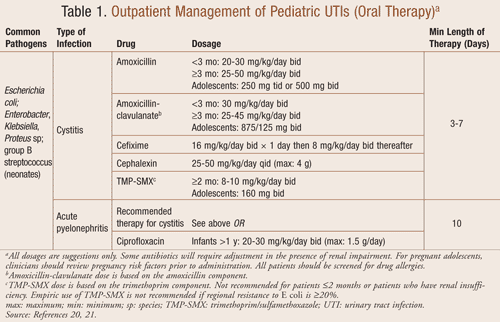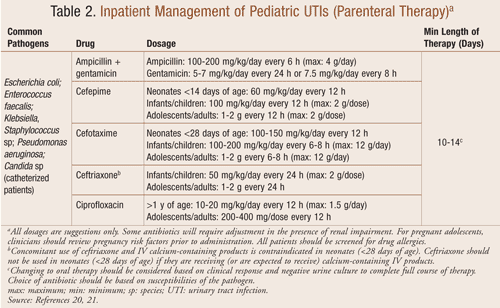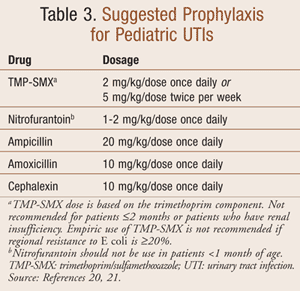US Pharm. 2011;36(3):HS2-HS7.
Urinary tract infections (UTIs) affect approximately 2.4% to 2.8% of children every year in the United States and account for nearly 1.1 million office visits annually.1 Hospital costs for pediatric patients with pyelonephritis (kidney infection) total greater than $180 million per year in the U.S.1 Diagnosis of a UTI may be difficult because young children often present with nonspecific symptoms such as fever, poor oral intake, vomiting, or irritability. Unlike adults, children may develop renal scarring and hypertension secondary to an acute infection. Prompt identification and treatment of a first or recurrent infection plays an important role in the prevention of sequelae. Many patients can be treated with oral antibiotics; however, young infants, the severely ill, or those not tolerating oral medications should be evaluated for IV antibiotic treatment.
Epidemiology
A true incidence of pediatric UTI has been difficult to determine because diagnosis is influenced by the patient selection, method of urine collection, and laboratory tests used. The most important variables influencing prevalence include the age and sex of the patient. Premature and low-birth-weight infants have higher rates of UTI as compared to full-term infants. During the first 6 months of life, uncircumcised boys are 10 to 12 times more likely to be infected; however, girls are more prone to a UTI in all other age groups.2,3 Children 1 to 5 years of age are most likely to experience their first symptomatic infection, with the incidence for girls in this age group ranging from 1% to 3%. Girls aged 6 to 16 years are 10 times more likely to have a UTI than boys, and as girls reach adulthood the incidence increases to approximately 10%.2,3 Of note, African-American girls have a lower rate of UTI relative to those of other races.2
Recurrent UTI in young girls is common, with the greatest risk occurring within the first few months after an infection. Approximately 75% of Caucasian and 50% of African-American school-age girls will experience a recurrence of a UTI within the first 3 years of their initial infection, compared to one-third of all males.4
Pathogens
The most prevalent pathogen causing UTI in children is Escherichia coli, attributed to nearly 80% overall and >90% of first infections in outpatients.5 Additional pathogens such as Pseudomonas aeruginosa, Klebsiella pneumoniae, Proteus species (sp), Enterobacter sp, and Enterococcus sp are known to cause UTI. Among patients with urinary tract anomalies or impaired immune systems, less virulent organisms such as Staphylococcus epidermidis, Haemophilus influenzae, and group B streptococcus may be responsible. Fungal UTI is most often caused by Candida albicans, especially in those patients with recent instrumentation of the urinary tract.6 Most UTIs in sexually active females are caused by E coli or Staphylococcus saprophyticus. The most common nosocomial pathogens include E coli, C albicans, and P aeruginosa.7 Recovery of Staphylococcus aureus from the urine normally suggests a hematogenous spread of infection such as a renal abscess, osteomyelitis, or bacteremia.
Risk Factors
The ability to empty the bladder is the most important mechanism against an infection; therefore, obstruction to normal flow of urine predisposes children to a UTI. Children with neurogenic bladder, detrusor-sphincter dyssnergia, and other urinary tract anomalies are at an increased risk for developing a UTI. Diabetes mellitus, frequent sexual intercourse, pregnancy, or a compromised immune system also predisposes individuals to UTI. Additionally, studies show that a recent history of antibiotic use, presence of an indwelling catheter, or a family history of recurrent UTI may increase risk. Risk factors predisposing males to a UTI include age <8 months and being uncircumcised. Circumcision has been shown to decrease the frequency of UTI by nearly 10-fold.8 Vesicoureteral reflux (VUR), the backflow of urine from the bladder into the ureter, can cause pyelonephritis and renal scarring due to the introduction of infected urine in the kidney.7
Classification
Functional classification categorizes an infection as either first or recurrent. Recurrent infections can be further categorized as unresolved bacteriuria (all cultures positive for the same organism), bacterial persistence (consistent positive and negative cultures from the same organism), and reinfection (positive and negative cultures from different organisms). A majority of UTIs in children resolve; however, inappropriate antibiotic therapy, nonadherence, malabsorption, and resistant organisms can potentially result in unresolved bacteriuria. Bacterial persistence is often seen in patients with anatomical abnormalities or foreign bodies, as treatment will sterilize the urine, but subsequent cultures will continue to be from the same organism. Reinfection may be caused by periurethral colonization or the development of a urinary tract-gastrointestinal tract fistula. On occasion, removal of the foreign body or surgical intervention to correct an abnormality is necessary to resolve bacterial persistence or reinfections.7
Clinical Presentation
A UTI is the presence of a pathogen in the kidney, ureter, bladder, and/or urethra. Patients with cystitis exhibit lower urinary tract symptoms (urgency, dysuria, and frequency) caused by inflammation of the bladder mucosa. Patients with pyelonephritis exhibit upper urinary tract symptoms (high fever, abdominal and/or flank pain) caused by inflammation of the renal parenchyma.7
Children with a UTI commonly present without the classic signs and symptoms often seen in adults, and these will vary based on the patient’s age. Infants <3 months of age often present with nonspecific symptoms, including fever, difficulty feeding, vomiting, irritability, lethargy, malodorous urine, and jaundice.9-11 However, children aged 3 months to 2 years often present with symptoms more specific to the urinary tract, such as cloudy or malodorous urine, increased urinary frequency, or hematuria, with nonspecific symptoms including fever, vomiting, anorexia, and failure to thrive.7 Children aged 2 to 5 years most commonly present with abdominal pain and fever. Children >5 years are more likely to present with symptoms such as dysuria, increased urinary frequency, and urgency.12
Diagnosis
Isolation of a pathogen from a urine culture is essential for a definitive diagnosis of a UTI.13 The urine culture should be obtained prior to initiation of antimicrobial therapy. A urine specimen can be collected by many methods including midstream clean-catch, suprapubic aspiration, urethral catheterization, and urine bag. While the least traumatic method is obtaining urine via urine bag, it is important to note the high rate of false-positives associated with this test.11 Urethral catheterization is used in younger children, while a midstream clean-catch is most commonly used in older children. Although a urinary catheter is more sensitive than the clean-catch or urine bag method, its placement is invasive and may introduce organisms to the urinary tract. To avoid risk of contamination by periurethral organisms, the initial portion of urine should be discarded. A urine culture obtained by urethral catheterization with a colony count >105 indicates a 95% probability of infection. A single urine culture obtained by clean-catch from a female patient with a colony count of ³105 indicates an 80% probability of infection.11
Unfortunately, culture results are usually not available in less than 24 hours; therefore, alternative testing methods are necessary to guide empiric antimicrobial therapy while the urine culture incubates. Urinalysis or urine microscopy results are often used to direct initial treatment. Serologic markers such as leukocyte esterase, nitrites, and the presence of white blood cells (WBCs) will aid in identification of an infection. Activated leukocytes produce leukocyte esterase; however, production is dependent on WBCs, which may not be present during a UTI. Certain bacteria, specifically gram-negative organisms, will reduce nitrates to nitrites. The sensitivity and specificity of these tests vary, with leukocyte esterase being the most sensitive (83%) and nitrite being the most specific (98%).11 Although a urinalysis can aid in therapy, a urine culture is imperative in the diagnosis of a definitive UTI.
Treatment
The goals of treatment for an acute UTI are to eradicate the infection, prevent urosepsis, and reduce the likelihood of renal damage.11 Initiation of an empiric antibiotic is based on the most likely pathogen and adjusted after results from a urine culture and susceptibility are reported. Patients with an underlying urinary tract abnormality or complicated history of recurrent UTI, unusual pathogens, or immunodeficiency may require a broadened antibiotic regimen.
Outpatient Treatment: Oral antibiotics are effective for outpatient treatment of UTI, including cystitis and acute pyelonephritis (TABLE 1). Timely treatment of acute pyelonephritis, particularly in younger children, is imperative to prevent renal injury and potential scarring. Use of oral cephalosporins may be appropriate agents; however, the clinician should recognize their ineffectiveness for an enterococcal infection. Empiric use of amoxicillin and trimethoprim/sulfamethoxazole (TMP-SMX) has limited use due to potential resistance of E coli. The FDA recently approved ciprofloxacin for complicated UTI and pyelonephritis in children.14 Ciprofloxacin is not a first-line agent in pediatrics due to increased adverse events related to joints and surrounding tissues.
Optimal duration of oral therapy for treatment of UTI has not been identified. Studies have proven that recurrence of UTI is higher in a single-dose or 1-day regimen as compared to a 3- to 4-day regimen.15 A total of at least 10 days of antibiotic therapy is recommended for children with presumed pyelonephritis, VUR, or other urinary tract abnormalities.11

Inpatient Treatment: Hospitalization for administration of IV antibiotic therapy may be indicated for children with a suspected UTI depending on the severity of their symptoms (TABLE 2). Very young infants, those presenting with a toxic appearance, severe dehydration, vomiting, or intolerance to oral medication should be considered for hospitalization. A recent study evaluating the duration of IV therapy for UTI in hospitalized patients <6 months of age concluded that there was no difference in treatment failures in those who had received £3 days versus ³4 days.16 Administration of IV antibiotics should be continued for a minimum of 3 days until blood culture results are negative or for a minimum of 24 hours after resolution of symptoms. Most patients will improve within 24 to 48 hours of therapy in which treatment can be changed to an oral antibiotic to complete a 7- to 14-day course.16
Effective treatment of UTI is essential to prevent long-term complications because acute UTI in children may result in renal scarring. Renal scarring is a known cause of hypertension in children; thus, preventative measures in high-risk patients, specifically those of female gender and with a history of severe VUR, are warranted.17 Radiographic studies such as a renal bladder ultrasound or voiding cystourethrography are recommended after resolution of an infection or a patient’s first febrile UTI to evaluate the degree of renal scarring and rule out urinary tract anomalies.

Prophylaxis
Prophylactic antimicrobial therapy for a UTI is aimed at sterilizing the urine in order to prevent renal damage and scarring. The prophylactic dose of antimicrobials is one-fourth to one-half of the therapeutic dose for an acute infection (TABLE 3).7 The optimal agent is administered orally and will attain a therapeutic drug concentration in the urine while sustaining low drug concentrations in the bowel to prevent development of resistant fecal flora. The optimal selection of a prophylactic agent should be based on local antimicrobial resistance patterns.

Prophylactic therapy should be considered in children with a history of recurrent UTI, VUR, immunosuppression, or partial urinary obstruction and be continued until resolution of the underlying predisposition.18 There is no definitive evidence for superiority of a single antibiotic in prevention of a UTI; however; cephalosporins should not be used for prophylaxis in patients with VUR. A recent study shows that children receiving cephalosporin prophylaxis are more likely to have breakthrough UTI from an extended-spectrum beta-lactamase–producing bacterium or multidrug-resistant uropathogen.19 TMP-SMX is preferred for prophylaxis in patients with VUR. Lastly, antibiotics used to treat infants and neonates for their first UTI should not be used for prophylaxis.
REFERENCES
1. Freedman AL. Urologic diseases in North America Project: trends in resource utilization for urinary tract infections in children. J Urol. 2005;173:949-954.
2. Ginsburg CM, McCracken GH Jr. Urinary tract infections in young infants. Pediatrics. 1982;69:409-412.
3. Foxman B. Epidemiology of urinary tract infections: incidence, morbidity, and economic costs. Am J Med. 2002;113(suppl 1A):5S-13S.
4. Winberg J, Anderson JH, Bergstrom T, et al. Epidemiology of symptomatic urinary tract infection in childhood. Acta Paediatr Scand Suppl. 1974;(252):1-20.
5. Kunin CM. Epidemiology and natural history of urinary tract infection in school age children. Pediatr Clin North Am. 1971;18:509-528.
6. Phillips JR, Karloqwicz MG. Prevalence of Candida species in hospital-acquired urinary tract infections in a neonatal intensive care unit. Pediatr Infect Dis J. 1997;16:190-194.
7. Feld L, Matoo TK. Urinary tract infections and vesicoureteral reflux in infants and children. Pediatr Rev. 2010;31:451-463.
8. Singh-Grewal D, Macdessi J, Craig J. Circumcision for the prevention of urinary tract infection in boys: a systematic review of randomized trials and observational studies. Arch Dis Child. 2005;90:853-858.
9. Honkinen O, Jahnukainen T, Mertsola J, et al. Bacteremic urinary tract infection in children. Pediatr Infect Dis J. 2000;19:630-634.
10. Garcia FJ, Nager AL. Jaundice as an early diagnostic sign of urinary tract infection in infancy. Pediatrics. 2002;109:846-851.
11. American Academy of Pediatrics Committee on Quality Improvement: Subcommittee on Urinary Tract Infection. Practice parameter: the diagnosis, treatment, and evaluation of the initial urinary tract infection in febrile infants and young children. Pediatrics. 1999;103:843-852.
12. Smellie JM, Hodson CJ, Edwards D, Normand IC. Clinical and radiological features of urinary infection in childhood. Br Med J. 1964;2:1222-1226.
13. Cheng YW, Wong SN. Diagnosing symptomatic urinary tract infections in infants by catheter urine culture. J Paediatr Child Health. 2005;41:437-440.
14. Cipro (ciprofloxacin) package insert. Wayne, NJ: Bayer HealthCare Pharmaceuticals Inc; October 2008.
15. Shapiro ED. Short course antimicrobial treatment of urinary tract infections in children: a critical analysis. Pediatr Infect Dis. 1982;1:294-297.
16. Brady PW, Conway PH, Goudie A. Duration of inpatient intravenous antibiotic therapy and treatment failure in infants hospitalized with urinary tract infections. Pediatrics. 2010;126:196-203.
17. Leonardo CR, Filgueiras MF, Vasconcelos MM, et al. Risk factor for renal scarring in children and adolescents with lower urinary tract dysfunction. Pediatr Nephrol. 2007;22:1891-1896.
18. Chang SL, Shortliffe LD. Pediatric urinary tract infections. Pediatr Clin North Am. 2006;53:379-400.
19. Cheng CH, Tsai MH, Huang YC, et al. Antibiotic resistance patterns of community-acquired urinary tract infections in children with vesicourteral reflux receiving prophylactic antibiotic therapy. Pediatrics. 2008;122:1212-1217.
20. Johnson CE, Corey HE, Elder JS. Urinary tract infections in childhood. Consensus Pediatr. 2003;1:1-28.
21. Children’s Medical Center. Pediatric Dosage Handbook. Hudson, Ohio: Lexi-Comp; 2010-2011.
To comment on this article, contact rdavidson@uspharmacist.com.





